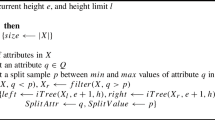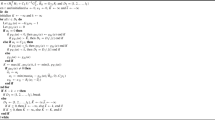Abstract
Fuzzy SVM is often used to solve the problem that patterns belonging to one class often play more significant roles in classification. In order to improve the efficiency and performance of fuzzy SVM, this paper proposes a new fuzzy twin support vector machine (NFTSVM) for binary classification, in which fuzzy neural networks and twin support vector machine (TWSVM) are incorporated. By design, the influence of the samples with high uncertainty can be mitigated by employing fuzzy membership to weigh the margin of each training sample, which improves the generalization ability. In addition, we show that the existing TWSVM and twin bounded support vector machines (TBSVM) are special cases of the proposed NFTSVM when the parameters of NFTSVM are appropriately selected. Moreover, the successive overrelaxation (SOR) technique is adopted to solve the quadratic programming problems (QPPs) in the proposed NFTSVM algorithm to speed up the training procedure. Experimental results obtained on several artificial and real-world datasets validate the feasibility and effectiveness of the proposed method.





Similar content being viewed by others
Explore related subjects
Discover the latest articles, news and stories from top researchers in related subjects.References
Cortes C, Vapnik VN (1995) Support vector machine. Mach Learn 20(3):273–297
Vapnik VN (2000) The nature of statistical learning theory. Springer-Verlag, New York (Incorporated)
Burges C (1998) A tutorial support vector machines for pattern recognition. Data Min Knowl Disc 2:1–43
Isa D, Lee LH, Kallimani VP, Rajkumar R (2008) Text document preprocessing with the Bayes formula for classification using the support vector machine. IEEE Trans Knowl Data Eng 20(9):1264–1272
Yen SJ, Wu YC, Yang JC, Lee YS, Liu LL (2013) A support vector machine-based context-ranking model for question answering. Inf Sci 224(1):77–87
You ZH, Yu JZ, Zhu L, Li S, Wen ZK (2014) A mapreduce based parallel SVM for large-scale predicting protein–protein interactions. Neurocomputing 145: 37–43
Mangasarian OL, Wild EW (2006) Multisurface proximal support vector machine classification via generalized eigenvalues. IEEE Trans Pattern Anal Mach Intell 28(1):69–74
Jayadeva, R Khemchandani, S Chandra (2007) Twin support vector machines for pattern classification. IEEE Trans Pattern Anal Mach Intell 29(5):905–910
Kumar MA, Gopal M (2009) Least squares twin support vector machines for pattern classification. Expert Syst Appl 36(4):7535–7543
Shao YH, Zhang CH, Wang XB, Deng NY (2011) Improvements on twin support vector machines. IEEE Trans Neural Networks 22(6):962–968
Peng XJ (2011) TPMSVM: a novel twin parametric-margin support vector machine for pattern recognition. Pattern Recognit 44(10):2678–2692
Qi ZQ, Tian YJ, Shi Y (2013) Robust twin support vector machine for pattern classification. Pattern Recognit 46(1):305–316
Wang Z, Shao YH, Wu TR (2014) Proximal parametric-margin support vector classifier and its applications. Neural Comput Applic 24:755–764
Shao YH, Chen WJ, Deng NY (2014) Nonparallel hyperplane support vector machine for binary classification problems. Inf Sci 263:22–35
Tian YJ, Qi ZQ, Ju XC, Shi Y, Liu XH (2014) Nonparallel support vector machines for pattern classification. IEEE Trans on Cybern 44(7):1067–1079
Chen SG, Wu XJ, Zhang RF (2016) A novel twin support vector machine for binary classification problems. Neural Process Lett 44(3):795–811
Ye QL, Zhao CX, N. Y, Chen YN (2010) Multi-weight vector projection support vector machines. Pattern Recognit Lett 31:2006–2011
Chen XB, Yang J, Ye QL, Liang J (2011) Recursive projection twin support vector machine via within-class variance minimization. Pattern Recognit 44(10):2643–2655
Shao YH, Deng NY, Yang ZM (2012) Least squares recursive projection twin support vector machine for classification. Pattern Recognit 45(6):2299–2307
Ding SF, Hua XP (2014) Recursive least squares projection twin support vector machines for nonlinear classification. Neurocomputing 130: 3–9
Ding SF, JZ Yu, BJ Qi (2014) An overview on twin support vector machines. Artif Intell Rev 42(2):245–252
Lin CF, Wang SD (2002) Fuzzy support vector machines. IEEE Trans Neural Networks 13(2):464–471
Jiang XF, Yi Z, Lv JC (2006) Fuzzy SVM with a new fuzzy membership function. Neural Comput Appl 15(3–4):268–276
An WJ, Liang MG (2013) Fuzzy support vector machine based on within-class scatter for classification problems with outliers or noises. Neurocomputing 110(7):101–110
Ding SF, Han YZ, JZ Yu, YX Gu (2013) A fast fuzzy support vector machine based on information granulation. Neural Comput Appl 23:139–144
Wang XZ, RAR Ashfaq, Fu AM (2015) Fuzziness based sample categorization for classifier performance improvement. J Intell Fuzzy Syst 29(3):1185–1196
Keller JM, Hunt DJ (1985) Incorporating fuzzy membership functions into the perceptron algorithm. IEEE Trans Pattern Anal Mach Intell 6:693–699
Tao Q, Wang J (2004) A new fuzzy support vector machine based on the weighted margin. Neural Process Lett 20(3):139–150
Khemchandani R, Jayadeva, Chandra S (2008) Fuzzy twin support vector machines for pattern classification. Mathematical programming and game theory for decision making. World Scientific, Singapore, pp 131–142
Li K, Ma HY (2013) A fuzzy twin support vector machine algorithm. Int J Appl Innov Eng Manag 2(3):459–465
R.O. Duda, P.E. Hart, D.G. Stork (2001) Pattern classification. Second edition, Wiley, Hoboken
Mangasarian OL, Musicant DR (1999) Successive overrelaxation for support vector machines. IEEE Trans Neural Networks 10(5):1032–1037
Lee YJ, Huang SY (2007) Reduced support vector machines: a statistical theory. IEEE Trans Neural Networks 13(1):1–13
Ripley BD (2008) Pattern recognition and neural networks. Cambridge University, Cambridge
Muphy PM, Aha DW (1992) UCI repository of machine learning databases. University of California, Irvine. http://www.ics.uci.edu/~mlearn
The USPS Database, http://www.cs.nyu.edu/~roweis/data.html
Nene SA, Nayar SK, Murase H (1996) Columbia object image library (COIL-20). Technical report CUCS-005-96, Department of Computer Science, Columbia University
Martinez AM, Benavente R (1998) The AR face database. CVC Technical Report #24
Wang XZ, He Q, Chen DG, Yeung D (2005) A genetic algorithm for solving the inverse problem of support vector machines. Neurocomputing 68: 225–238
Wang XZ, Lu SX, Zhai JH (2008) Fast fuzzy multi-category SVM based on support vector domain description. Int J Pattern Recognit Artif Intell 22(1):109–120
Wang XZ (2015) Uncertainty in learning from big data-Editorial. J Intell Fuzzy Syst 28(5):2329–2330
Acknowledgements
This work was partially supported by the National Natural Science Foundation of China (Grant No. 61373055 and 61672265), the University Natural Science Research Project of Anhui Province of China (Grant No. KJ2015A266, KJ2016A431 and KJ2017A361) and the University Outstanding Young Talent Support Project of Anhui Province of China (Grant No. gxyq2017026).
Author information
Authors and Affiliations
Corresponding author
Rights and permissions
About this article
Cite this article
Chen, SG., Wu, XJ. A new fuzzy twin support vector machine for pattern classification. Int. J. Mach. Learn. & Cyber. 9, 1553–1564 (2018). https://doi.org/10.1007/s13042-017-0664-x
Received:
Accepted:
Published:
Issue Date:
DOI: https://doi.org/10.1007/s13042-017-0664-x




